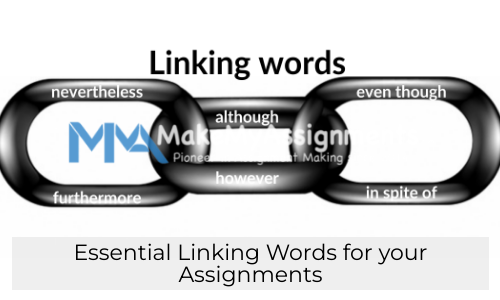
Essential Linking Words for your Assignments
Are you stuck with your assignment? Want to know about the use of linking words that can make your assignment look attractive? Then this blog is the best place for you. Here we will explain what linking words are and how they can make your assignment look interesting. So, without wasting any more of your time, let’s just begin with it.
During a conversation, you might have witnessed that people jump from one topic to another, and no doubt, it’s a very weird experience because it gets difficult for you to stay connected with it. In that place, linking words will help you remember them properly. In order to seek the attention of your readers and ensure that they’re not distracted from your conversation, the first thing that you need to do is think properly and weave a plot around it for better comprehension. This will help your readers understand your point of view.
As the name itself suggests, linking words are those words that create a connection between sentences. With the help of linking words, students frame their assignments thoroughly. The only purpose of employing linking words in your content is that it helps build a bridge between your words and thoughts. In most cases, the readers are not interested in reading the whole assignment and understanding its hidden meaning. So, whenever you start writing with your assignment, make sure that your writing is simple and understandable.
Types of Linking Words
Sometimes it is quite difficult for students to compile thought-provoking assignments for their academics. And if you want to enrich the quality of your assignment, then you need to arrange the information properly and represent it in the most appealing way. But before doing that, you need to have the skills to use linking words in your content; otherwise, all of your efforts will go in vain. Linking words play a crucial role in representing your content. Here are some of the major types of linking words that you can use in your writing-
Order and sequence-related words: First, second, third, etc, at the same time, previously, following this, the end, once upon a time, so, thus, next, then, primarily, after, secondarily, first of all, hence.
Words that show comparison: Compared to, like, as, in the same way, likewise, equally, similarly.
Contrasting words: Though, although, in spite of, apart from, however, alternatively, on the contrary, while, yet.
Illustrative words: For example, to show that, such as, an instance, for instance, in the case of, as an example.
Words of addition: Likewise, along with, lastly, either…or, neither…nor, as well as, besides, still, not only…but also, furthermore, also, next, again, finally, along, further, such as, then, in addition to, and, or.
Cause and effect words: Consequently, since, owing to, because, for this reason, thus, so, resulting in, for, due to, as a result of, hence, caused by, leads to, results from, therefore.
Conclusion related words: To sum up, conclusion, thus, as a result of, in summary, evidently, in the long run, overall, consequently, then, hence, finally, to conclude, all in all, briefly, summarizing in, in short, after all.
Understanding these words first and then placing them in the right position is not a tough job. But the only thing that you need to do is build your complete focus towards your assignment. Here are some of the techniques that can be used well to place these words-
At the beginning of a sentence: Linking words can help you begin your sentence as it gives reference to the last point.
In the middle of a sentence: You can also use these linking words in the middle of a sentence.
At the end of a sentence: To end your assignment well, you can finish your sentence with some linking words.
Hope by now you are aware of what linking words are and how they can be used in your assignments. Apart from this, if you ever need help regarding your academic papers or assignments, feel free to contact our online assignment writing services for professional help and guidance.




